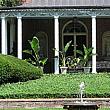
John Blodgett Visits Blodgett Hall at Vassar College
In the fall of 1933, Vassar College initiated two experiments in cooperative living. These initiatives, one in existing residence halls (Raymond and Main) and the other in a reconfigured Blodgett Hall, were part of an effort to help students lower their costs during the financial crisis of the Depression. Many Vassar girls were determined to finished their education, and by doing some of the housekeeping chores they were able to save some money and remain at school. The plan called for students in Raymond, Main, and Blodgett to earn an aggregate of $22,000 during the 1933-34 academic year. Considering that the cost of tuition, room and board was $1200 per student, the projected savings were significant.
A more extensive experiment in cooperative living was also begun in a fall of 1933 when Blodgett Hall was converted to allow students residence. A group of upperclass students moved in and shared all responsibilities for meal planning, table setting, cooking and cleaning, with a reduction in room and board costs. Blodgett Hall had been designed as the home of the Department of Euthenics. The first group of students who moved in joked that, while the building was appropriate for the study of the betterment of living conditions, it was unsuitable as a cooperative dormitory. A student might have to go through several bedrooms in order to get to her own, and the bathroom was located near the boiler room next to a room filled with biological experiments. Nevertheless, the students appeared to enjoy the experience and worked diligently to make the project successful.
In April 1937, the students living in the cooperative house invited John Blodgett to visit the campus and have dinner with them that spring. In a letter written on April 26 to one of the student leaders of the house (Martha Jack '37), Blodgett wrote:
I have heard more of less of the efficiency developed by cooperative house keeping in Blodgett Hall – especially efficiency regarding menus, food combinations, etc. May I, therefore, ask that you, or a committee of your choosing take over for me the question for our dinner on May 7th, and relieve me of it entirely? I would suggest four courses, which might include a soup, meat, salad, and dessert. It if is possible to find such a thing I hope you will take advantage of the opportunity and have a meat course that you do not often have in Blodgett Hall, where I assume the broiling and roasting facilities are somewhat limited. I will be delighted and look in at the 'Blodgett Brawl' on the Saturday night following. Thank you for the suggestion.
Blodgett opted not to attend the "Brawl" as he notes in a May 28 follow up letter:
President MacCracken and I did not venture into Blodgett that Saturday evening because from the laughter and sounds we heard we knew instinctively that something very important was going on, and we suspected dish-washing. We feared that some of the young men might get nervous at the sight of us and break some china, which we knew would be a calamity. Permit me to again say hoe greatly I enjoyed meeting the Blodgett crowd.
Excerpted from the Vassar Encyclopedia. Full text and a photograph of Blodgett Hall

 facebook
facebook

